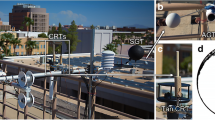Abstract
Research was conducted into the estimation of radiation absorbed by a vertical cylinder in complex outdoor environments under clear sky conditions. Two methods of estimation were employed: a cylindrical radiation thermometer (CRT) and model developed by Brown and Gillespie (1986), and the weather station model. The CRT produced an integrated temperature reading from which the radiant environment could be estimated successfully given simultaneous measurements of air temperature and wind speed. The CRT estimates compared to the measured radiation gave a correlation coefficient of 0.9499, SE=19.8 W/m2, α=99.9%. The physically-based equations (weather station model)require the inputs of data from a near by weather station and site characteristics to estimate radiation absorbed by a vertical cylinder. The correlation coefficient for the weather station model is 0.9529, SE=16.8 W/m2, α=99.9%. This model estimates short wave and long wave radiation separately; hence, this allowed further comparison to measured values. The short wave radiation was very successfully estimated:R=0.9865, SE=10.0 W/m2, α=99.9%. The long wave radiation estimates were also successful:R=0.8654, SE=15.7 W/m2, and α=99.9%. Though the correlation coefficient and standard error may suggest inaccuracy to the micrometeorologist, these estimation techniques would be extremely useful as predictors of human thermal comfort which is not a precise measure buut defined by a range. The reported methods require little specialized knowledge of micrometeorology and are vehicles for the designers of outdoor spaces to measure accurately the inherent radiant environment of outdoor spaces and provide a measurement technique to simulate or model the effect of various landscape elements on planned environments.
Similar content being viewed by others
References
Brown RD (1985) Estimation of remote microclimates from weather station data with applications to landscape architecture: University of Guelph, Ontario, Canada
Brown RD, Gillespie T (1986) Esamating outdoor thermal comfort using a cylindrical radiation thermometer and an, energy budget model Int. J. Biometeorol 30: 43–52
Campbell GS (1977) An introduction to environmental physics. Springer, Berlin Heidelberg New York
Cherkezoff LE (1988) Testing of traditional systems and design of a method for including microclimatology in landscape design: University of Guelph. Ontario Canada
de Freitas CR (1985) Assessment of human bioclimate based on thermal response. Int J Biometeorol 29: 97–119
Lam W (1986) Sunlighting as formgiver for architecture. Van Nostrand Reinhold. New York
Watson, ID, Johnson GT (1988) Estimating person view-factors from fish-eye Jens photographs. Int J Biometeorol 32: 123–128
Author information
Authors and Affiliations
Rights and permissions
About this article
Cite this article
Krys, S.A., Brown, R.D. Radiation absorbed by a vertical cylinder in complex outdoor environments under clear sky conditions. Int J Biometeorol 34, 69–75 (1990). https://doi.org/10.1007/BF01093450
Received:
Revised:
Accepted:
Issue Date:
DOI: https://doi.org/10.1007/BF01093450




